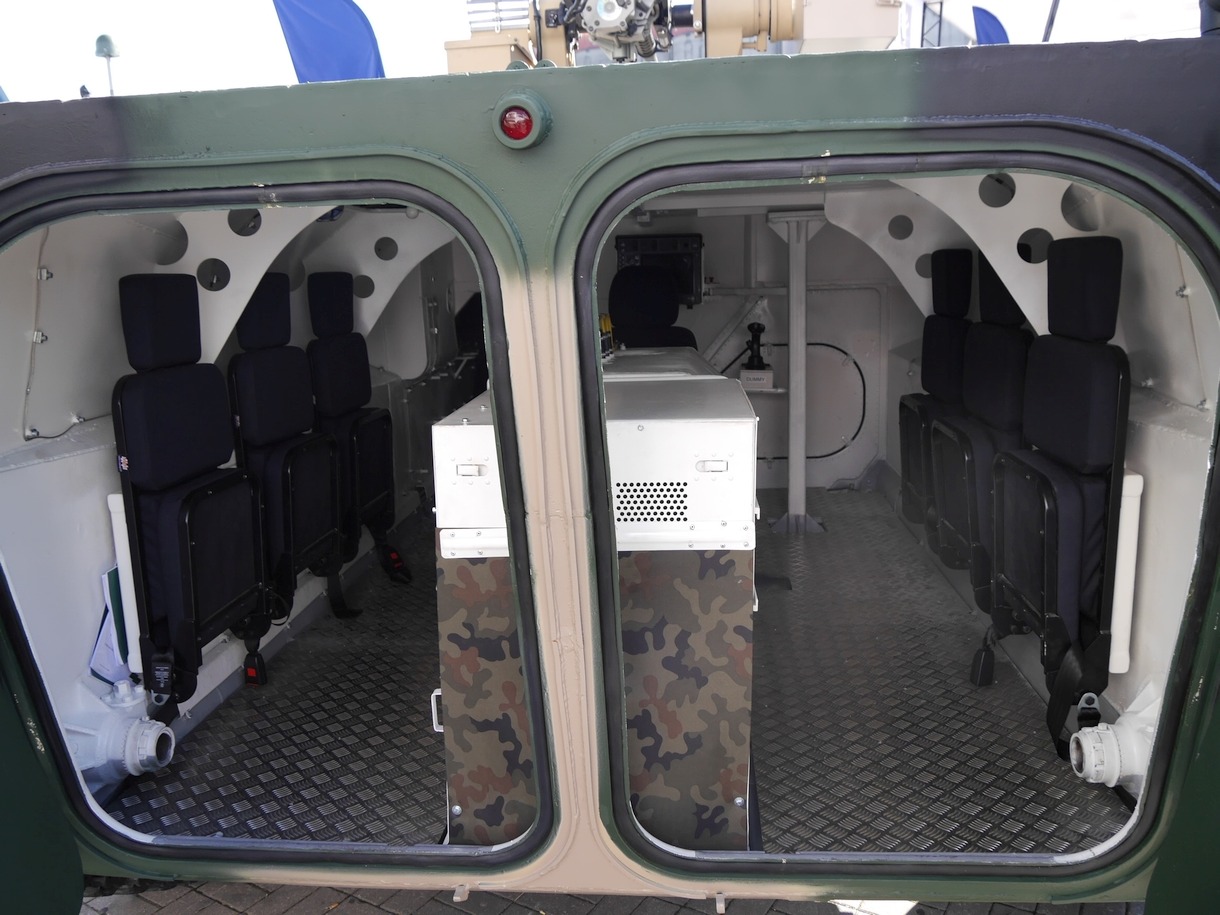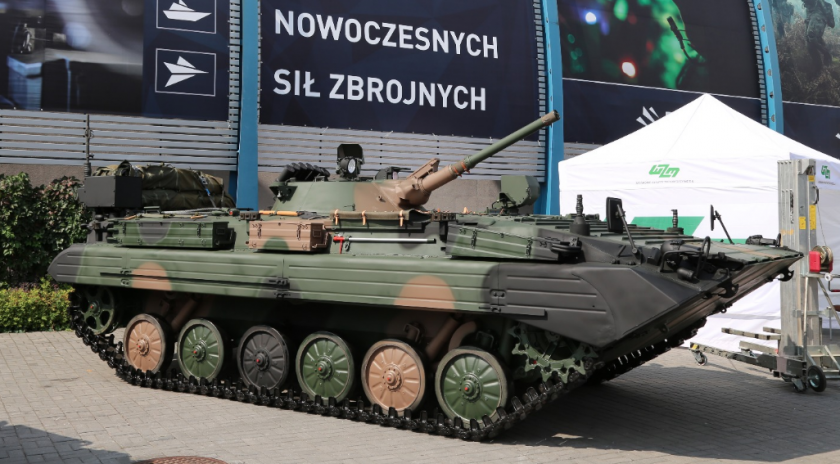Polish Modernization of BWP-1 [ANALYSIS]

WZM facility in Poznan is creating a proposal for the modernization of the BMP-1 IFVs. This year, a prototype of a vehicle with a modified hull structure design is to be born. Then it would be probably integrated with specialist equipment - as writes Mateusz Zielonka.
The Poznan-based PGZ Group’s WZM facility has been working on maintenance and overhaul services concerning the Polish military’s BWP-1 fleet for years. The experience that the facility gathered, along with its capabilities, altogether translated into the emergence and presentation of original upgrade packages for these platforms, of varying depth of the implemented modifications, depending on the requirements.
Recently, the company has begun to prepare a new proposal responding to the requirements issued by the Armament Inspectorate. The proposal is to meet the assumptions of the BWP-1 upgrade programme as defined by the Technical Modernization Plan. It is a gap-filler solution that would precede the induction of the new Borsuk IFVs - the project in question is pursued by HSW S.A. within the framework of undertaking initiated by the National Centre for Research and Development (with power packs being developed by WZM). Because more than 10 mechanized battalions would receive the Borsuk platforms, the deliveries would be time-consuming. Delivery of specialist variants of the platform would also be required.
Thus a decision was made to modernize the BWP-1s in parallel, with technical dialogue covering that matter being pursued right now. Although 12 entities originally submitted their bids, three remained, after the qualification. PGZ S.A. and WZM S.A. are acting as one of the bidders. There is a great probability then, that the upgrade task may be assigned to the Poznan-based plant. According to information provided to us by WZM S.A., the modernization proposal would entail changes in two key areas, plus extra and optional elements.
The first one comes in a form of a replacement of the obsolete, manned turret, with a modern unmanned system. Different solutions are supposedly being taken into the account here, resulting on the grounds of market analysis. ZSSW-30 had also been considered, at the early stage of the project. Unfortunately, the current variant of that turret has been rejected, due to the excessive weight. HSW S.A., the manufacturer of the aforesaid solution, has proposed a lighter system utilizing the ZSSW-30’s technology. It is being considered now. Systems that could be delivered by foreign partners are also being considered. The company has not revealed the solutions proposed yet. The final configuration, meanwhile, may depend on the specific nature of the requirements.
The second change would involve redesigning the hull - mainly by making it taller. This is to enhance comfort and ergonomics and make it easier to integrate new systems. It could also lead to extra enhancement of safety if the Ordering Party decides to install seats that could absorb the explosion energy. This is one of the possible upgrade options, already presented and showcased during the MSPO 2019 exhibition in Kielce.

At the same time, the final height of the vehicle should not drastically change its silhouette, with simultaneous improvement of the operation. The company also declares that the heightening of the hull shall not be tied directly to the integration of a new turret module. The new system, being unmanned, would not have any basket underneath, and most of it would stay outside of the interior of the vehicle.
The plans also cover the following issues: replacement of the intercom and the external comms suite with modern counterparts, including ones already fielded in the Polish military, replacement of the electronics, fire extinguishing, explosion dampening, and air filtering/ventilation systems, and changes of the drivetrain. Optionally, replacement of the A/C and heating systems and modernization of the power pack are also being considered. The current modernization proposal assumes that the vehicle should be able to retain its autonomous amphibious capacity. The condition to keep the amphibious nature of the vehicle alive is one of the key ones, taken into account when it comes to defining the final configuration of the new upgrade.
The Poznan-based facility declares that it would place a major emphasis on undertaking a joint effort with other Polish defence industry entities, and on integrating solutions and systems already developed and manufactured, for the BWP-1 upgrade. The programme is also to involve a broad array of PGZ S.A. companies, including the following entities: PIT-RADWAR S.A., WCBKT S.A., HSW S.A., ZM Tarnów S.A., PCO S.A., and Dezamet S.A. When it comes to the foreign partners who would be delivering the key components for the upgrade process in question, the transfer of technology to Poland is planned. Furthermore, WZM S.A. has also engaged in an R&D initiative involving the Military University of Technology (WAT) and the Military Institute of Armoured and Automotive Technology (WITPiS).
The Poznan-based company is already getting ready to implement the BWP-1 modernization programme - also when it comes to the vehicle design itself. Since 2019, tests concerning the planned design changes have been going on. The effort undertaken to optimize the new hull is also coming to a completion. This year, a prototype would be created. The prototype, meanwhile, would make it possible to carry out a preliminary integration of components planned for integration on the modernized BWP-1 vehicle.
For the first time, WZM S.A. presented a technology demonstrator of the currently developed BWP-1 upgrade package within the outdoor exhibition of PGZ S.A., organized during the MSPO 2019 event in Kielce. The proposal was a comprehensive upgrade project for the BWP-1 platform. The scope of changes covered all of the key areas, such as survivability, mobility, or firepower. Kongsberg Protector RWS LW-30 unmanned module replaced the original turret - however, this has been just one of the possible solutions. The final selection is still a matter of scrutiny. The technology demonstrator showcased during MSPO also took into account improvement of the protection levels, up to STANAG 4569A level 3 or 4. Furthermore, the crew safety was to be enhanced even further, by explosion-proof seats, already mentioned by the herein article.
The vehicle was also fitted with new communications assets and a fire extinguishing system, as well as reinforced suspension. The heightening of the hull, clearly visible, made it possible to improve crew comfort and install new systems. Currently, as mentioned above, the hull optimization process is in its final stage. The final prototype is to be rolled out by the end of this year.

WZM S.A. based in Poznan has already upgraded the Polish fleet of the BWR-1D/S reconnaissance vehicles which is proof of the know-how required to execute similar programmes. The modification was implemented differently, within the framework of overhauls. The Armament Inspectorate was not the Ordering Party here. That role was taken by the 1st Regional Logistics Base in Wałcz, subordinated to the Armed Forces Support Inspectorate. According to the regulations in force, the BWP upgrade would be pursued by the Armament Inspectorate of the Polish MoD. Formally it would result in the introduction of new equipment into the inventory. Modification is a part of an overhaul, thus it is not viewed as the introduction of new equipment. In the case of the BWR, the Poznan-based facility carried out overhauls, repairs, and a broad range of modifications. The mission equipment was replaced in its entirety - which allows the upgraded BWRs to effectively carry out their mission.
Read more: MSPO 2018: Two BWR Vehicle Upgrades
Some of the currently operated BWP-1 vehicles could undergo an upgrade in Poznan, within the scope that would be defined by the user. The vehicles in question, thanks to the new, unmanned turrets, and other new equipment components would have their capabilities gradually improved, especially in the firepower and situational awareness departments. Thanks to the above, they could remain in service as a piece of valuable combat equipment, until they are fully replaced by the new Borsuk IFV platform. Introduction of the latter would take time, also considering the necessity to rearm the newly formed elements of the 18th Mechanized Division. Modernization of the BWP-1 platform and introduction of the Borsuk IFV may be complementary, allowing the Polish Army to reinforce its capabilities.
Article prepared in collaboration with WZM S.A.
